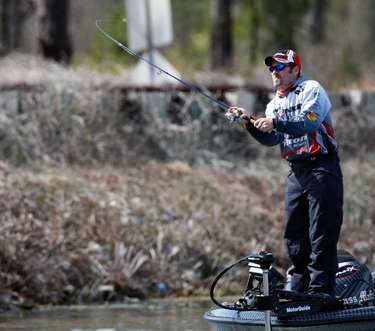
Tracking bass in the early fall reminds Stephen Browning of a similar hit-and-miss situation he encounters in the deer woods.
"It's almost like deer hunting where right before the rut everything gets kind of funky and then, all of a sudden, everything gets wide open," Browning said. "You go through a short period when the fishing is really tough because I think you have a lot of shad that are trying to transition, and you have a lot of fish that are trying to transition with them, but the major move hasn't come on yet.
"The summertime pattern of deeper brushpiles and long points and things like that start playing out (due to the shad movement). Bass are going to be where they can get fat and happy, so the fish will be in the first third of the creek channels and shallower on main lake points."
The Arkansas pro notices that shad in his part of the country start their fall migration when the water temperature drops into the lower 80s. While backs of creeks are favorite targets of several anglers during this time, Browning looks for baitfish in shallower water toward the fronts of the creeks and main lake pockets where the fish have just started migrating from deeper water.
"What I normally do is transition to a shallower zone of water," he said. "Whether it's a river system, natural lake or man-made reservoir, I fish from 2 to 8 feet deep instead of that summertime range from 8 to 18 feet out."
Since shad will be feeding heavily on algae in early fall, chunk rocks coated with the green slime are Browning's favorite targets for bass during this time.
He searches for chunk rock banks or pea gravel flats that feature a 2- to 3-foot dropoff where bass can quickly move up into the shallows to ambush baitfish. Weather and wildlife help Browning pinpoint early fall bass.
"Wind plays a big key when you start to look for fall bass more so than it does during the summertime," said Browning, who keys on any areas where wind will be stirring up the algae and drawing in baitfish.
"My big thing is also to look for the birds that feed on the baitfish. A blue heron is the ultimate angler. Those birds will be up on the bank or on the end of a tree and will be hunting baitfish.
"So pay attention to where they are positioned. Are they on a creek channel swing or a shallow flat or out belly deep in the water or are they up on the bank letting the wind blow up the baitfish?"
If the wind is blowing and Browning notices bass are aggressive, he favors burning a Koppers Live Target Golden Shiner lipless crankbait (1/4- or 1/2-ounce models depending on the size of the forage) in the shallows. He also will throw a Chatterbait along the windblown flats.
On calm days, Browning opts for a more subtle bait such as the Live Target Shad crankbait. Early fall tends to produce good numbers of fish, but can be a tough time to catch a kicker bass.
"A lot of times you just have to go through them," Browning said." It's a situation where you might go through two or three places and catch four, five or six fish from each spot.
"A lot of times you can just change baits and make another pass through the area to trigger a bigger strike. You can also change depths and go a little deeper. If you're catching the smaller fish shallower, tie on something that will get down underneath the water column you are fishing.
Instead of working hard and doing a lot of chasing, those bigger fish get kind of lazy and tend to feed on the fish that are drying and going to the bottom."





